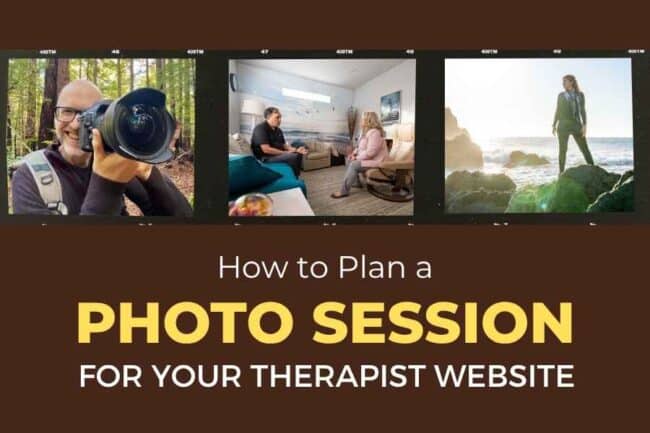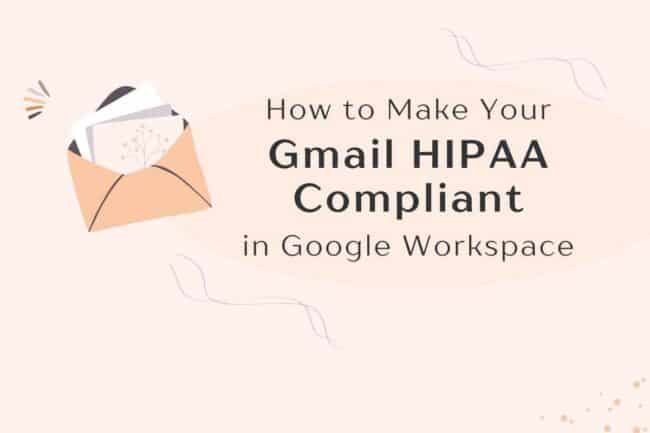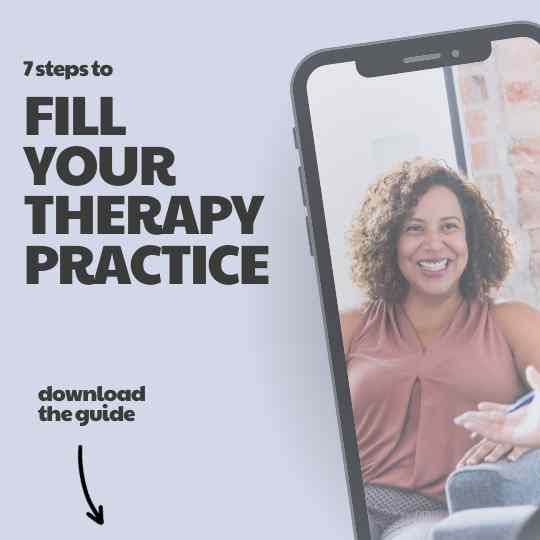Welcome to: Therapist Marketing 101
I hear it all the time from therapists and, quite, frankly, it’s B.S.
You invest $200k for grad school, put in endless supervision hours, and then finally pass your exams. Congrats — you’re officially licensed! Now what?!
How is “Intro to Therapist Marketing” not a core part of every grad school curriculum?!
New therapists are stuck wondering how to get enough non-insurance clients to pay off your debt? What makes you stand out in the crowd – and how the heck do you build and promote a website?
Or, maybe you’ve been in practice for years and your old referral sources have dried up. Now, you’re trying to promote yourself in a very crowded online market and don’t know how to get ahead.
Then, of course, we’ve got the crazy world of COVID – where all therapy is online and people don’t have the same disposable income they did in the “good old days.”
Table of Contents
I’ve been helping therapists grow their practices since 2006. To help you get started, I have compiled all my best therapist marketing techniques and guides into this one comprehensive resource.
- Building a Foundation for Your Practice
- Creating a Successful Therapist Website
- Search Engine Optimization (SEO) for Therapists
- SEO Keyword Research
- PPC Advertising on Google & Facebook
- Social Media for Therapists
- Marketing Automation
- Traditional Marketing
- Everything Else
Building your foundation
Before you invest a dime in website design or therapist marketing, you need to understand who you most want to help. This is the person that you look forward to seeing across from you: week after week.
Whether you’re a recently-licensed therapist or you’ve been in practice for years, the first step is to do some self-discovery work.
Choosing Your Therapy Niche
The first step towards creating a successful therapy practice is to identify your niche.
Many therapists neglect this step. They mistakenly believe that they should keep their therapy practice open to any client who is willing to walk through the door.
However, when you find the right niche, your practice will truly thrive.
Niche (adj): a specific problem that you help solve for a specific group of people.
You may be thinking, “I want to help as many people as possible ” Or, “If I choose a niche, I won’t get enough new clients.”
The logic is that if you narrow your scope to only a very small demographic (i.e., families with toddlers or corporate executives), you’ll be able to make your marketing more targeted.
Once developed, your niche acts as the foundation for everything you do to promote your practice.
[button color=”accent-color” hover_text_color_override=”#fff” image=”default-arrow” size=”large” url=”https://goodmancreatives.com/how-to-choose-a-niche-for-your-therapy-practice/” text=”LEARN: how to choose a therapy niche” color_override=””]
Creating a Dream Client Avatar
Avatar (n): a person (singular) who embodies your perfect patient.
The idea is to make your dream client avatar as real as possible. Take your time and really get to know them.
Give them a name, occupation, hobbies, hopes, fears, favorite books, etc. For some, it may even be helpful to find a picture of someone you feel resembles your dream client.
Once identified, this avatar will be the person your practice lives to serve.
They will become the foundation of your website, your therapist marketing, and everything else you do. This is not to say that you’re going to alienate other visitors – it just helps keep a consistent tone and voice to your writing and promotional activities.
[button color=”accent-color” hover_text_color_override=”#fff” image=”default-arrow” size=”jumbo” url=”https://goodmancreatives.com/therapists/self-discovery-course/” text=”EXPLORE: our self-discovery eCourse” color_override=””]
Creating a Successful Therapist Website
Once you have a clear understanding of who you want to serve, it’s time to develop a website that speaks directly to them.
Whatever platform you use (Therapist Themes, Squarespace, WordPress, etc), the goal is to create a deep personal connection with the visitor and inspire them to reach out for help.
And don’t worry if your website isn’t perfect when you launch it. The amazing thing about your therapist website is that you can update it whenever you want!
Writing Amazing Copy for Your Therapist Website
When writing copy for your website, it’s essential to remember that the person visiting is not an expert on therapy.
Your dream client isn’t looking for big words or technical jargon – they are looking for the same warmth and compassion they want in a therapist.
The words on your website should walk them through a virtual intake call.
By the time your dream client clicks “contact,” they should feel like they know you and understand your approach, personality fees, and if you are a fit.
Here are 5 tips to get you started:
- Make it about them – use “you” statements and avoid describing people as “clients.”
- Describe what they are feeling – think about the words your current clients use in session.
- Get them involved – ask questions in their voice (e.g., “how can therapy help?”). Then, answer those questions as if you’re having a casual conversation.
- Don’t diagnose – the DSM-5 is for you … not them
- Tell them to reach out – at least once per page, remind them to contact you for help.
Choose Photos that Reflect Your Dream Client
If your dream client is a 45-year-old woman with kids, don’t put photos of men at the office or 20-somethings hiking up a mountain.
The photos on your therapist website are often more important than the words you use.
Think about it. When you’re quickly scrolling through a website, what’s more likely to get your attention: a chunk of text or a pretty photo
Every therapist website photo has the chance to:
- Make a personal connection with your dream client
- Tell them a bit about yourself
- Show them that you “get them”
- Demonstrate that you’re here to help
Also, please try to avoid photos of zen rocks, water droplets, trees, sand gardens, and other cliched imagery. While these stereotypical images do a great job of demonstrating a calm and relaxing environment, they are missing out on the opportunity to do so much more.
[button color=”accent-color” hover_text_color_override=”#fff” image=”default-arrow” size=”large” url=”https://goodmancreatives.com/free-photos-for-therapy-websites” text=”DOWNLOAD: 30 Free Photos” color_override=””]
Provide a Contact Form on Every Page
Think about the mindset of a potential new therapy client. They are probably feeling anxious, vulnerable, intimidated or scared. Odds are, they have looked at several therapy sites, and are searching for a reason to connect.
So, what differentiates you from all the others? What makes them contact you instead of the group practice down the street? Quite simply, it’s how easy you make it for them to get in touch!
It’s a proven fact that adding a contact form to every page of your website can help you increase the number of people reaching out.
By having a contact form on every page of your website, you allow their impulse to control their action. It’s much easier to fill out a quick form than to click on a “Contact Me” button, call you, or send an email.
[button color=”accent-color” hover_text_color_override=”#fff” image=”default-arrow” size=”large” url=”https://goodmancreatives.com/therapist-website-design-contact-forms/” text=”LEARN: more about therapist contact forms” color_override=””]
Offer a Free Phone Consultation
You do this anyway – it’s called your intake call. So, why not promote it on your website.
On every contact form, use big bold text to say, “reach out for a free phone consultation” or “schedule a free Q&A call.”
Better yet, offer them a way to schedule this call themselves using an online calendar app. I recommend Calendly – it’s free, easy, and integrates with most website platforms.
»» Here’s an example of what Calendly looks like in action.
Search Engine Optimization (SEO) for Therapists
We live in a strange world … a place where your website has to appeal to both humans and search engine robots.
It may seem counterintuitive. Yet, that’s exactly what you have to do to succeed online. Welcome to the world of SEO for therapists.
Search Engine Optimization (SEO) is the art of getting your dream customer to visit your website without paying for advertising.
Sounds simple enough, right? Just figure out the magic formula, do it once, sit back, and profit! Sadly, this isn’t how it works. The reality is, the world of SEO is an always-changing landscape.
While there are myriad components that go into any successful SEO campaign, they can all be broken down into two key categories:
- Onsite SEO: The text, keywords, image tags, titles, links, mobile-friendliness, site speed, and everything else in the backend of your site
- Offsite SEO: Every single link that points to you lets Google know that your site is important. The higher quality the website linking to you, the more sway it holds with your search engine ranking.
Sounds like a lot, right?
Spoiler alert: it is!
But it doesn’t have to be overwhelming.
»» Here’s a quick guide to building your Therapist SEO Foundation.
. . .
Set up a Therapist Google My Business Listing
Sometimes known as “Google My Business,” it’s that box that comes up to the right side of a Google search that has reviews, photos, a map, and more.
Your local business listings are a key part of local SEO and therapist marketing. Getting a local business listing is easy and free – all you need is a Google account to sign up. Start by heading to google.com/business, then follow the steps outlined there.
[button color=”accent-color” hover_text_color_override=”#fff” image=”default-arrow” size=”large” url=”https://goodmancreatives.com/therapist-google-business-listing-optimization/” text=”HOW: to set up your Google My Business listing” color_override=””]
Getting Links to Your Therapist Website
When your therapist website goes live, it’s like an island in the middle of the ocean. There are no bridges, ferries, or cell phone towers (thank goodness for that last one).
While this is great for an island retreat, it’s terrible for SEO. That’s why you’ve got to start letting Google know that your site is out there by getting other websites to link to yours. The more links you get, the better for your overall Therapist SEO.
Each external link pointing to your site is like a bridge telling Google, “people like this therapist website.”
Here are a few ways you can get started building your therapist backlink profile.
- Local chambers of commerce
- Guest posting on other blogs
- Yelp
- Therapist directory sites (more on that later)
- The Hoth (a paid service to build links)
Therapist SEO Keyword Research
You’ve probably already heard about the importance of keywords. Each time that someone enters a phrase into a search engine such as Google, that’s their keyword.
You need to tell Google what the important keywords are on your site.
Start by using one specific keyword on each page or post on your site. (Power Tip: each page can have secondary keywords and variations)
For example, if your keyword is “Arizona couples counselor” then you might also incorporate similar phrases such as “Couples counselor in Arizona.” Additionally, that page might have a related secondary keyword such as “relationships.”
How to find the Best Therapist SEO Keywords
First, brainstorm the list of keywords that you want using the ideas above. Once you have that list, you can expand your keyword list by using keyword research tools. There are some useful tools available for free.
One good place to start is the Google Keyword Tool.
Google is the most popular search engine, so it makes sense to use their tool to come up with keywords. You’ll need to create a free Google AdWords account to use this tool. Once you do, you can enter your keywords to come up with lists of related keywords.
This tool provides information about the number of searches people do for each keyword. In other words, you can see which terms are most popular so that you can implement them into your website.
How to Use SEO Keywords on Your Website
Here are a few power-tips on how to best use SEO keywords on your therapist website.
- Include the keyword phrase in your page title
- Put the keyword phrase in at least one subheading on the page
- Make sure the keyword phrase is in the first paragraph. Ideally, it will be in the first sentence.
- Include the keyword phrase towards the end of the page as well.
- Use the keyword phrase enough times that it makes up between 5% and 1.5% of the text on the page.
- Name images with the keyword phrase. Add the keyword phrase in the “alt tag” and the “description” of each image. However, use a slightly different variation on the phrase if you’re using more than one image because you don’t want to duplicate it exactly
- If your website is built on WordPress, download and install the Yoast SEO plugin.
 PPC Advertising on Google & Facebook
PPC Advertising on Google & Facebook
We’ve already talked about SEO, which is the best way to build a foundation for your therapy practice and a key part of therapist marketing. Over time, SEO will allow you to stop paying for ads, as people find your website organically.
However, SEO can take 6-8 months before you even start to see results. In the meantime, you’ll probably need to consider paid advertising to get visitors to your website.
PPC advertising means you “Pay Per Click” — aka, you pay for every visitor to your website.
When determining your PPC budget, first think about the lifetime value of a new therapy client. If each person you treat pays an average of $2,500 – then spending $1,000 to get that client is a bargain.
However, if your average new client only needs three sessions to be cured (hahaha), then paying $1,000 to get them into your chair is a waste of money.
Google Ads: Get Found Fast
The fastest way to get your website on Page 1 of Google is to pay them for that “honor.” However, there’s a common misconception about how Google Ads works.
All Google promises you is that they will get people to visit your website. They hope that those people become clients, but that part is completely up to you.
Here’s a quick reality check:
- On average, you’re paying between $5 and $15 for every person who clicks on your ad.
- Industry standards suggest that a 5% conversion rate (aka, how many people reach out) is a big success.
- Taking those numbers, if you invest $500 per month on Google Ads, you MIGHT get 5 people filling out a contact form or reaching out for help.
- Keep in mind, that doesn’t mean 5 new clients – you still need to have a successful intake call.
Before you do AdWords, here’s my advice:
Don’t do Google Ads until your website is ready. That means having a website that speaks directly to your dream client and gives them plenty of ways to reach out.
Don’t use Google Adwords Express. It doesn’t give you enough control over where your budget goes.
[button color=”accent-color” hover_text_color_override=”#fff” image=”default-arrow” size=”jumbo” url=”https://goodmancreatives.com/marketing/google-ads-for-therapists/” text=”LEARN: about our google ads management services” color_override=””]
Facebook Ads for Therapists
Investing in Facebook ads for therapists is a great idea – as long as you don’t need quick results. Here’s the scoop.
When someone does a Google search, they have the intent to hire a therapist. That’s why Google Ads is such a good solution. However, on Facebook, people are mostly looking for a mindless distraction from their life. Funny cat videos and cute photos of their nephews – not lifechanging therapy.
Think of Facebook Ads as the billboard on the side of the road.
You need to use your FB ad budget to create content that people are excited to click on. Create your personal connection by sharing articles you’ve written – and then boost those posts with a healthy budget of $50-$100 per article.
Then, use your Facebook tracking pixel to create an audience of people who have visited your site. Those are the people you want to actually show ads to … to introduce to your services.
As I said, Facebook advertising is more of a long-haul approach. However, done right (aka, with patience and a big budget), it can produce results.
Social Media for Therapists
There’s a 99.99% chance that your dream client is on social media … clicking around and trying to distract themselves from what’s really troubling them.
That means you should ALSO be on social media – educating your dream client about your practice and inspiring them with the amazing content you create.
Sounds like a lot of work, huh? Spoiler Alert: it is … but it can also be a lot of fun!
Start by choosing one platform. Facebook is a good one – as is Instagram.
Then, think about what your dream client is going through and what they would want to see to “feel better.” Use hashtags, polls, questions, imagery, stories, and more to brighten their day.
Then, when it’s time for them to finally reach out for help, you will be the first therapist they think of.
** In my experience, Twitter and LinkedIn don’t work well for most therapists … and Google+ is long gone.
What to post on a Facebook Business Page
As I mentioned above, a Facebook presence is like having a billboard on the side of the road. It can leave an impression – but your dream client has to “drive-by it” hundreds of times before anything sticks.
While it’s great to share interesting content from other sources, your #1 goal should be educating your dream client about YOUR practice.
This means regular blogging – and sharing those blog posts. It also means creating content just for Facebook – like inspirational quotes over images.
7 ways to use Facebook to promote your therapy practice.
- Be selective about what you post.
- Educate your followers.
- Encourage your fans to like or interact with your posts.
- Use Facebook Live.
- Focus on sharing the content you create.
- Target your boosted posts.
- Keep trying new things.
What’s also great about Facebook is when you boost your content (aka, pay to promote it), you can also share that same content on Instagram and across hundreds of other sites in the Facebook network.
[button color=”accent-color” hover_text_color_override=”#fff” image=”default-arrow” size=”large” url=”https://goodmancreatives.com/facebook-business-pages-guide/” text=”READ: a guide to posting on facebook” color_override=””]
Therapist Marketing Automation
Marketing automation is all the rage these days – and for good reason. You set it up then sit back and watch as your dream client enters into a highly-targeted sequence of events.*
* OK, that’s a bit of a simplification – a successful marketing automation is always a work in progress.
It’s also worth noting that getting people to actually enter your automation is a bit of a challenge. Let’s be honest … people aren’t chomping at the bit to get regular communications from a therapist they’re not seeing.
The secret is to give them something that they can benefit from … for free.
That’s how you get them into your marketing funnel and your automation. Then, you need to create a personal connection, inspire them, and get them to reach out.
Marketing Funnels for Therapists
A marketing funnel is a series of steps that guide your dream client as they move from “random Google visitor” to “paying client and referral source.”
Visually, it consists of four or more concentric “funnel” circles. Each of these circles represents a stage in the customer’s journey.
Here’s a simplified example of a therapy practice’s digital marketing funnel.
- Awareness – You google “therapist near me”
- Interest – You sign up for my newsletter
- Evaluation – I wow you with my free resources
- Commitment – We have an intake call
- Sale – You start therapy
[button color=”accent-color” hover_text_color_override=”#fff” image=”default-arrow” size=”large” url=”https://goodmancreatives.com/what-is-a-digital-marketing-funnel/” text=”LEARN: all about marketing funnels” color_override=””]
Automated Emails
In the above example, the “Interest Stage” is a core part of the marketing funnel.
A newsletter is a great way to share resources and keep in touch – and by automating your emails, you can “set it and forget it.” That means that every new person who signs up gets the same series of emails: each dedicated to creating that all-important personal connection.
Automated emails include everything from an initial “thanks for signing up” email to re-engagement emails sent to remind potential clients of what you have to offer.
They are personal and highly targeted, which is perfect for the therapy business where the one-on-one touch really matters.
»» The easiest way to get started is to sign up for a free Mailchimp account and follow their guide.
Traditional Therapist Marketing
Marketing is dead. Long live marketing!
If you ask most therapists, handing out business cards, putting up flyers, and getting in touch with local doctors is a complete waste of time. Then, there are those occasional therapists who have a success story to tell …
Jean recently had a table at a health fair. She handed out flyers — and left with 75 potential clients’ email addresses.
That’s the kind of success story that inspires me to continue suggesting traditional marketing for therapists. If anything, our reliance on digital marketing has resulted in fewer people doing these old-school methods. Which means, the door is wide open!
Here are a few tried-and-true traditional therapist marketing techniques.
- Writing letters to local physicians
- Attending health fairs
- Create and sell custom products
- Hosting workshops and events
- Volunteering at a hospital
- Going on public radio as an expert
Everything Else
HARO
The simplest, fastest to get media exposure without spending a penny is by using a powerful, free PR service called Help A Reporter Out or HARO.
HARO is a free service that connects journalists with experts like you.
Through HARO, you can get featured in over 55,000 media outlets including top publications like TIME, USA Today, and The Washington Post.
In addition to getting coverage for your practice, you should (in theory) also get a valuable backlink to your website.
Psychology Today + Other Directory Sites
Over the years, there’s been a lot of debate on the value of online directory sites like Psychology Today and GoodTherapy.
On one hand, they seem like a great way to get more referrals and increase your therapy practice’s online presence. On the other hand, every therapist you know seems to be listed on those sites.
Do you really need to be on Psychology Today?
Plus, if you’re thinking that being listed on these sites will help with your SEO, think again. Many of the most popular sites (including Psychology Today) actually mask your URL, so you don’t get the SEO benefit of having a link on their site.
So how do you choose which therapist directory site you should list your practice on? As a rule of thumb, “if it’s free, you should be (there).”
If you have to pay, do your research first. Here are a few things to think about:
- How many therapists are listed?
- Does that site come up in a Google search when you try to find a therapist in your area?
- Where is the site based out of?
- Does the site have a free trial?
- Is the site’s philosophy or about page in line with your own?
- Does the site provide “real” backlinks?
[button color=”accent-color” hover_text_color_override=”#fff” image=”default-arrow” size=”large” url=”https://goodmancreatives.com/pros-cons-therapy-directory-sites/” text=”MORE: about therapist directory sites” color_override=””]
Get an SSL Certificate
Have you ever noticed a little lock icon and the word “secure” next to a URL in your web browser?
When you see that, it means that the site has an added layer of security called an SSL certificate. You also may notice that the URL begins with https instead of http. The extra “S” is for “secure.”
In addition to being important for SEO, having an SSL certificate inspires trust in your dream client.
Think about all the subconscious factors that go into building trust with a potential therapy client.
You’re dedicating so much time and energy into creating a website that speaks to your dream client, why risk turning them off by having a non-secure site … especially when your ultimate goal is getting their personal information (name and phone number, not PHI).
[button color=”accent-color” hover_text_color_override=”#fff” image=”default-arrow” size=”large” url=”https://goodmancreatives.com/google-seo-penalty-no-ssl-certificate/” text=”LEARN: all about SSL Certificates” color_override=””]
YouTube Videos
What better way to display your authentic self than by showing the world your smiling face?
In today’s digital world, people connect deeply with videos posted on YouTube (and Facebook, Vimeo, etc). The key is figuring out what your dream client wants to hear.
Here are a few video ideas:
- An Intake – walk a potential client through your process, just like you would on a phone call
- Self-Help – choose an issue that most of your clients suffer from, then give them ways to help themselves
- Open Up – share something personal that you’re comfortable sharing (ideally, something that you would share anyway in session)
A blog
If you have a website, you need a blog.
For therapists, blog writing should be a core part of your marketing strategy. It will help you get more visitors, increase your reach, keep people moving through your sales funnel, and boost your SEO.
If you’re wondering why you should start blogging, here are 4 great reasons to inspire you:
- New content gives people a new reason to visit your website (which they probably haven’t done in a while).
- You can share each article on social media and in your newsletter.
- Well-written blog posts make a personal connection with your customers and help establish you and your business as an industry leader.
- Google loves to see new content added to your website, which is great for SEO
[button color=”accent-color” hover_text_color_override=”#fff” image=”default-arrow” size=”large” url=”https://goodmancreatives.com/blog-marketing-techniques/” text=”LEARN: how to get your blog post noticed” color_override=””]
Even More Therapist Marketing Ideas
Well, this post sure did get long! I hope it’s filled you with inspiration for getting more paying clients into your therapy practice.
As time goes on, I plan to update this post with even more ideas. In the meantime, here are a few final resources and ways to improve your therapy website.
- Create an inspirational “About” page
- Ditch your website’s resources page
- How to fix 7 of the most common website mistakes
- Sign up for our “Keys to a Successful Therapist Website” eCourse.
How Can I Help You?
»» Got Questions?
»» Want to learn how I can grow your practice?
[button color=”accent-color” hover_text_color_override=”#fff” image=”default-arrow” size=”large” url=”https://goodmancreatives.com/schedule-a-call” text=”SCHEDULE A FREE 15-MINUTE Q&A CALL” color_override=””]
Or, for more amazing therapist resources, sign up for my newsletter.
Thanks for reading … and keep making the world a better place!
~ Greg Goodman
Founder and Head Creative

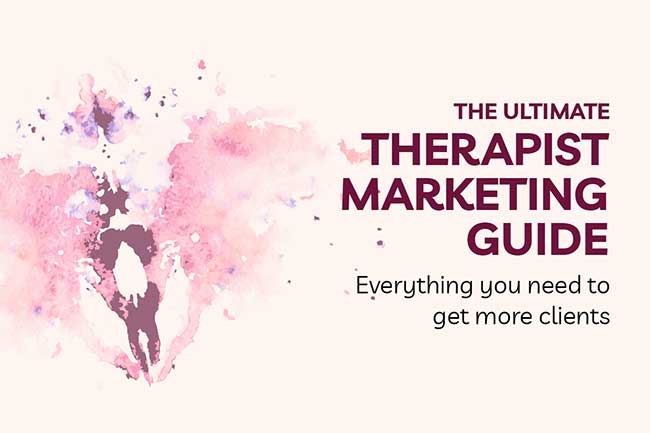
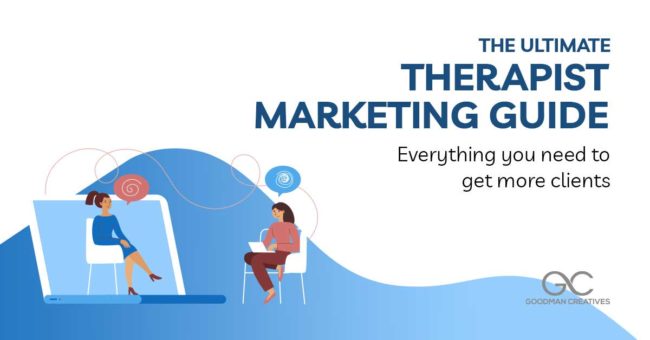



 PPC Advertising on Google & Facebook
PPC Advertising on Google & Facebook






